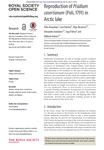Reproduction of Pisidium casertanum in Arctic lake
| dc.contributor.author | Bespalaya, Yulia | en_US |
| dc.contributor.author | Bolotov, Ivan | en_US |
| dc.contributor.author | Aksenova, Olga | en_US |
| dc.date.accessioned | 2016-07-18T06:49:08Z | |
| dc.date.available | 2016-07-18T06:49:08Z | |
| dc.date.issued | 2015 | en_US |
| dc.identifier.other | HPU4160431 | en_US |
| dc.identifier.uri | https://lib.hpu.edu.vn/handle/123456789/22274 | |
| dc.description.abstract | Freshwater invertebrates are able to develop specific ecological adaptations that enable them to successfully inhabit an extreme environment. We investigated the brooding bivalve of Pisidium casertanum in Talatinskoe Lake, Vaigach Island, Arctic Russia. Here, quantitative surveys were conducted, with the collection and dissections of 765 molluscs, on the basis of which analyses on the brood sacs length (marsupia) and the number and size of embryos, were performed. | en_US |
| dc.format.extent | 13 p. | en_US |
| dc.format.mimetype | application/pdf | |
| dc.language.iso | en | en_US |
| dc.subject | Biology | en_US |
| dc.subject | Ecology | en_US |
| dc.subject | Adaptive strategy | en_US |
| dc.subject | Arctic | en_US |
| dc.subject | Asynchronous brooding | en_US |
| dc.subject | Embryonic growth | en_US |
| dc.subject | Pisidiumspecies | en_US |
| dc.subject | Adaptive coin-flipping | en_US |
| dc.title | Reproduction of Pisidium casertanum in Arctic lake | en_US |
| dc.type | Article | en_US |
| dc.size | 1.04MB | en_US |
| dc.department | Education | en_US |
Files in this item
This item appears in the following Collection(s)
-
Education [806]

